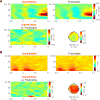Predictability's aftermath: Downstream consequences of word predictability as revealed by repetition effects
- PMID: 29414458
- PMCID: PMC5869124
- DOI: 10.1016/j.cortex.2017.12.018
Predictability's aftermath: Downstream consequences of word predictability as revealed by repetition effects
Abstract
Stimulus processing in language and beyond is shaped by context, with predictability having a particularly well-attested influence on the rapid processes that unfold during the presentation of a word. But does predictability also have downstream consequences for the quality of the constructed representations? On the one hand, the ease of processing predictable words might free up time or cognitive resources, allowing for relatively thorough processing of the input. On the other hand, predictability might allow the system to run in a top-down "verification mode", at the expense of thorough stimulus processing. This electroencephalogram (EEG) study manipulated word predictability, which reduced N400 amplitude and inter-trial phase clustering (ITPC), and then probed the fate of the (un)predictable words in memory by presenting them again. More thorough processing of predictable words should increase repetition effects, whereas less thorough processing should decrease them. Repetition was reflected in N400 decreases, late positive complex (LPC) enhancements, and late alpha/beta band power decreases. Critically, prior predictability tended to reduce the repetition effect on the N400, suggesting less priming, and eliminated the repetition effect on the LPC, suggesting a lack of episodic recollection. These findings converge on a top-down verification account, on which the brain processes more predictable input less thoroughly. More generally, the results demonstrate that predictability has multifaceted downstream consequences beyond processing in the moment.
Keywords: Alpha power; Repetition; Sentence comprehension; Word predictability.
Copyright © 2017 Elsevier Ltd. All rights reserved.
Figures





Similar articles
-
Lingering expectations: A pseudo-repetition effect for words previously expected but not presented.Neuroimage. 2018 Dec;183:263-272. doi: 10.1016/j.neuroimage.2018.08.023. Epub 2018 Aug 11. Neuroimage. 2018. PMID: 30107258 Free PMC article.
-
How long-term memory and accentuation interact during spoken language comprehension.Neuropsychologia. 2013 Apr;51(5):967-78. doi: 10.1016/j.neuropsychologia.2012.12.016. Epub 2013 Jan 29. Neuropsychologia. 2013. PMID: 23376769
-
Additive effects of repetition and predictability during comprehension: evidence from event-related potentials.PLoS One. 2014 Jun 6;9(6):e99199. doi: 10.1371/journal.pone.0099199. eCollection 2014. PLoS One. 2014. PMID: 24905459 Free PMC article. Clinical Trial.
-
Reading words in discourse: the modulation of lexical priming effects by message-level context.Behav Cogn Neurosci Rev. 2006 Sep;5(3):107-27. doi: 10.1177/1534582306289573. Behav Cogn Neurosci Rev. 2006. PMID: 16891554 Free PMC article. Review.
-
Prediction in reading: A review of predictability effects, their theoretical implications, and beyond.Psychon Bull Rev. 2025 Jun;32(3):973-1006. doi: 10.3758/s13423-024-02588-z. Epub 2024 Oct 31. Psychon Bull Rev. 2025. PMID: 39482486 Free PMC article. Review.
Cited by
-
Connecting and considering: Electrophysiology provides insights into comprehension.Psychophysiology. 2022 Jan;59(1):e13940. doi: 10.1111/psyp.13940. Epub 2021 Sep 14. Psychophysiology. 2022. PMID: 34520568 Free PMC article.
-
The impact of face masks on the recall of spoken sentences.J Acoust Soc Am. 2021 Jan;149(1):142. doi: 10.1121/10.0002951. J Acoust Soc Am. 2021. PMID: 33514131 Free PMC article.
-
Prediction during language comprehension: what is next?Trends Cogn Sci. 2023 Nov;27(11):1032-1052. doi: 10.1016/j.tics.2023.08.003. Epub 2023 Sep 11. Trends Cogn Sci. 2023. PMID: 37704456 Free PMC article. Review.
-
Temporal stability of semantic predictions in subclinical autistic and schizotypal personality traits.Schizophrenia (Heidelb). 2025 Jul 19;11(1):103. doi: 10.1038/s41537-025-00643-9. Schizophrenia (Heidelb). 2025. PMID: 40683910 Free PMC article.
-
Age-related Changes in the Structure and Dynamics of the Semantic Network.Lang Cogn Neurosci. 2022;37(7):805-819. doi: 10.1080/23273798.2021.2019286. Epub 2022 Mar 6. Lang Cogn Neurosci. 2022. PMID: 36262380 Free PMC article.
References
Publication types
MeSH terms
Grants and funding
LinkOut - more resources
Full Text Sources
Other Literature Sources

